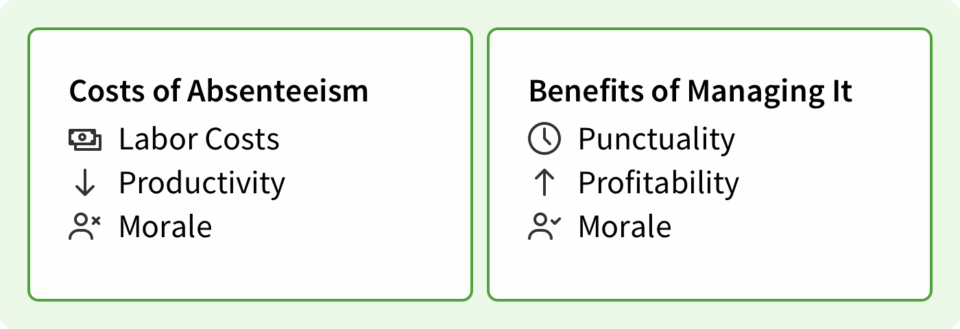6 Steps To Manage Absenteeism In The Workplace
Try When I Work for free
At first glance (or late clock in), employee absenteeism and tardiness may not seem like that big of a deal. After all, emergencies happen. Shifts get rearranged, and it can feel good watching your team come together and cover for a sick coworker.
But what if every once in a while becomes at least once a month, or even once a week?
What if absenteeism stops becoming every now and then, and instead becomes a pattern of behavior?
You’ll need a way to deal with the problem of absenteeism—and you’ll need to develop a process to make sure it’s handled properly so the issue is resolved. If you’re not sure where to start, this article will walk you through how to deal with employee absenteeism so you can build a process around it and use it every time you have this issue.
Key takeaways
- Employee absenteeism can decrease productivity, profitability, and morale
- Developing a clear attendance policy can help mitigate absenteeism in the first place
- Employee scheduling and time tracking software like When I Work helps you track attendance and find the root cause of issues
Get software designed to help you stay on top of employee absenteeism. Try When I Work for free and start tracking absences easier.
What is employee absenteeism?
Employee absenteeism is a frequent lack of attendance at work without valid cause. Absenteeism does not include the occasional no-call, no-show or instances that can’t be controlled, like illness or car trouble.
According to the U.S. Bureau of Labor Statistics, 7.8 million workers had an illness-related work absence in January 2022, up 110% from the 3.7 million from the previous year. In 2022, absenteeism cost U.S. companies $225.8 billion, about $1,685 per employee.
Harmful consequences of avoiding absenteeism management
Having someone call out every now and then doesn’t seem like a big deal. It happens, people get sick or have emergencies. But when the problem becomes chronic, you’ll have much bigger problems on your hands, including:
Decreased productivity and profitability
Obviously, if there are less people working, you’re going to have decreased productivity. And the fewer people who are available to provide service to customers, care to patients, or work the line, the less money you’ll be making that day. You’ll have unsatisfied customers and your reputation could suffer from bad reviews and word of mouth—both of those things could harm your bottom line. Would you want to go back to a restaurant that was chronically understaffed?
Increased labor costs
When someone calls out, either you have to go short handed or another employee has to pick up the shift. What if the only person available to work is now in overtime? You have to make that call. When you choose the wellbeing of your other employees, and ask someone to stay, so not everyone has to pick up the slack of being understaffed, you’ve now just paid more in labor for the shift than you were expecting to. If this happens a few times a month or even once a week, it can really put a dent in your profitability.

Low employee morale
Imagine you’re an employee who does everything in their power to come to work for each shift. You rush to make public transportation, you scramble to find childcare for a constantly-changing schedule, and you deal with the different shifts you get every week. Now imagine you work with someone who consistently calls out of their shifts every other week, but faces no consequences for doing so. You might be a little upset that you work hard and they don’t, but it doesn’t matter. You don’t feel valued, and they don’t face repercussions for how their actions affect everyone else.
Employees notice these things. And when you don’t address them, it’s the kind of issue that can make good, reliable employees leave to find another job where they feel like their efforts are appreciated. So even though you might feel like you’re being understanding to the person with an absenteeism issue, your lack of action is sending the wrong message to your staff that comes in day after day.
How to deal with employee absenteeism in the workplace
Employee absenteeism can be difficult to address once it’s become a habit or accepted behavior by your team. After all, you can’t force employees to show up to work on time. But instead of watching the costs of unexpected absences add up, try this six-step process to reduce employee absenteeism in the workplace:

1. Create an employee attendance policy
The first step in learning how to handle employee absenteeism? Create an official employee attendance policy. Workplace attendance should be straightforward—show up on time, as scheduled. But in reality, figuring out how to track, document, and fix employee absenteeism can get complicated, and come with a lot of IFTTW—if that, then what—scenarios. What if an employee comes in 45 minutes late, but still shows up? What if they have a sick child or another emergency? What if they don’t show up for work at all? Then what?
It doesn’t matter if your business doesn’t have an official HR department or if you have five or fifty employees. An official attendance policy makes expectations for work behavior and disciplinary action clear to all team members. So take some time now to put together a policy that’s fair to both you and your employees. Consider different attendance issues like scheduled absences, unscheduled absences, and tardiness, then decide any necessary disciplinary actions and next steps for each. It doesn’t need to be complicated. Instead, focus on creating a policy that rules out subjectivity and defines what each type of absence means in clear, plain language.
Download the free employee attendance policy and customize it to your needs!

Once you’re finished, don’t just stick your brand new attendance policy in a binder on the shelf or hide it in the fine print of an employee handbook. Make sure every employee, including new hires, has the chance to see it and is made aware of the changes. Emphasize the importance of attendance as a shared responsibility and that everyone is expected to hold up their end of the bargain. Have your employees sign a waiver confirming that they’ve read the policy and that they consent to work under the new attendance requirements. It’s a good idea for your records to confirm it in writing should any disciplinary issues arise later. And speaking of disciplinary issues…
2. Enforce your attendance policy consistently
A habit doesn’t crop up overnight. A pattern of employee absenteeism is something that develops over time and may already be seen as accepted behavior by the time the issue lands on your desk. In order to learn how to handle employee absenteeism in the workplace, you have to enforce your attendance policy consistently, each and every time.
That doesn’t mean you can’t show employees empathy or can’t have any wiggle room for emergencies. Instead, proactively build those situations into your policy. Have some escalation for unscheduled absences. One may be acceptable, but two may trigger a formal review. But remember: an unscheduled absence is much different than a “no-show.”
Texting that they’ll be late, swapping with a coworker, or calling in sick at least gives you notice that an employee won’t make it into work as scheduled and may give you time to find a replacement or prepare for an understaffed shift. A no-show can leave you wondering where they are, what happened, and leave your entire team hanging. Have a different plan of action for both attendance scenarios and apply it to all employees—including supervisors and management.
3. Keep track of employee absences
When it comes to dealing with employee attendance, it’s important to keep complete records. How to track employee absenteeism depends on what works best for you and any shift leads or supervisors who will be enforcing the attendance policy. One easy way to track your employees’ time is with a time clock app, which provides useful clock in/clock out notifications right away.
Every time an absence arises, make a note of it, either in your employee timekeeping system or in an employee performance tool. Or, consider putting together a stand-alone spreadsheet just for tracking attendance issues and timesheets. Without a strategy in place for how to document employee absenteeism at work, it may be hard to keep track of employee attendance and flag when one-off unscheduled absences start to become a pattern.
If your team is small enough, limiting access to yourself may be enough to track employee behavior. But if you’re not able to be everywhere at once, make sure other supervisors also have a way of documenting absences and late arrivals—even if it’s just a separate column or a notation on that weeks’ shift schedule.
Why document everything? Most states have legalized at-will employment, meaning employees can be dismissed without employers having to establish “just cause” for termination. However, that doesn’t mean you have a blank check to fire whoever you want—bad firing practices can still put you at risk for a wrongful termination suit, and your first line of defense is a well-documented paper trail.
Absences can also fall under the Family & Medical Leave Act (FMLA) and Americans with Disabilities Act (ADA) compliance, which provide employees with legal protection or accommodation for different types of absence “events.” Some states have enacted mandatory paid sick leave as well. Keep track of different absences, including both scheduled and unscheduled absences, to make sure you’re fulfilling your legal requirements as an employer. And in the case that you do need to let an employee go for absence-related issues, you’ll have a record that supports your decisions.
Related: 10 Best Attendance Apps For Your Business | When I Work
4. Address unscheduled absences and no-shows immediately
Absences happen. But when an employee does call in sick or fails to show up for a shift, directly address the situation. Don’t let too much time (or even another absence) pass in between. Once they return to work, sit down and have a conversation about what happened, why it happened, and what’s expected of them moving forward. Make sure they know if their absence has triggered any type of disciplinary action or a performance plan.
Depending on how long the absence has been, you may even want to hold a formal return-to-work interview. Return-to-work interviews positively impact absence rates and may even work better for small employers. By addressing absences first thing when they return, employees will recognize that their behavior is taken seriously and isn’t sliding by unnoticed.
5. Don’t just treat the symptoms, discover the cause
There are valid legal reasons for extended employee absences like FMLA or ADA compliance. For other scenarios, now’s the time to decide where you’ll draw the line. How often can an employee call in on Fridays and Mondays before it triggers formal action? Can they just not seem to make it in on time every other Tuesday? Is one no-show too many?
If you’re noticing a pattern in an employees’ attendance, call it out. Ask them directly why their absences tend to fall on certain days, and use your documentation as evidence. Point out specific times and dates and see how they respond.
You may find out there are other things outside of work impacting your employee’s attendance and leading to excessive absences. There may have been a shift in their daycare schedule which makes it hard to find a babysitter on certain days of the week. They may have started night classes and be struggling to make it in on time in the mornings. In the end, it may not be the employee at all, but their schedule.
If your employees have valid reasoning for excessive absences and their performance is strong otherwise, find a way to correct things together. Create a performance improvement plan, update employee availability forms, and adjust schedules where you can as needed. Set goals for them over the next 30 days—including no more absences or tardiness. But if they’re just missing work to kick off their weekend early, it’s time for some hard decisions.
The key here is not to let things go too far. Hopefully, your new employee attendance policy will flag and correct attendance issues at their start. Keeping an open line of communication with your employees can also help them feel comfortable discussing any issues with their work schedules that could lead to absences.
6. Don’t forget to reward good behavior
Think back to which of your employees missed work, came in late, or called in sick over the last month. Now, think of the ones who didn’t. Was it harder? Easier? Who stood out more?
In the workplace, absence is often felt more strongly than presence, and for good reason. If someone doesn’t show up to do their job, it puts a strain on the entire team. But what about the employees who do show up on time every day and keep your business running smoothly in the background?
Let’s take a look at the statistics:
- Employees who don’t feel recognized at work are twice as likely to say they intend to quit in the next year, while employees who are recognized are more loyal and engaged.
- In today’s growing millennial workforce, up to 76% of millennials say they would leave a job if they didn’t feel appreciated.
- Only one in three workers in the U.S. “strongly agree” that they received recognition or praise for doing good work in the past seven days.
Recognizing employees for good attendance and performance can be one of the lowest cost, yet highest impact strategies for your business. While you may want to focus on weeding out the employees with poor performance, you don’t want to lose the great employees you have in the process. Find a way to call out and reward good attendance on a regular basis. Incentivize employees to make the list next month by offering rewards they won’t want to miss, like an extra day off or a chance to choose their own schedule for a week.
Start your free 14-day trial of When I Work! Click here to start scheduling your employees today.

Common causes of employee absenteeism
Employee absenteeism can be a symptom of what’s happening within the workplace, but usually it’s a matter of something going on in your worker’s personal life that is causing the problem. Whether it’s a chronic health or mental health issue, a lack of childcare, or struggles with transportation, there’s most likely a personal reason your employee is absent. Being flexible with them and their schedule can help you both get back on track.
Track employee absences with When I Work
There’s no overnight solution when it comes to how to fix employee absenteeism. You’re likely still going to field calls about surprise “food poisoning” or the always-convenient Friday flu. But by implementing a fair employee attendance policy, documenting and tracking attendance patterns, having an action plan, and remembering to call out good attendance as often as the bad, unscheduled absences will start to become the exception, not the rule.
When you use When I Work to build your employee schedule, you give your team the ability to request time off and swap and drop shifts to help you stop attendance issues at the root. You can also use When I Work to run attendance reports and track trends, so you can be sure to address any concerns before they become bigger challenges.
You may not be able to solve every attendance scenario, but you’ll be able to set fresh expectations for your team and have a strategy in place for employee absenteeism moving forward.
Sign up for your free 14-day trial of When I Work to help you take control of absenteeism in the workplace.
FAQs: Absenteeism in the workplace
Q: What can absenteeism cost businesses?
A: Absenteeism management can be costly for businesses. In 2020, for instance, absenteeism reportedly cost U.S. companies approximately $3,600 for each hourly worker.
Q: How can businesses deal with absenteeism in the workplace?
A: Businesses can address absenteeism by implementing a fair employee attendance policy, consistently enforcing it, keeping complete records of absences, addressing unscheduled absences and no-shows immediately, trying to understand the underlying causes of absences, and rewarding good attendance.
Q: What is the role of an employee attendance policy in managing absenteeism?
A: An employee attendance policy plays a crucial role by making expectations for work behavior and disciplinary action clear to all team members. The policy should define different types of absences and the respective consequences in clear language.
Q: How important is it to document absences in the workplace?
A: Documenting absences is vital as it enables businesses to track attendance patterns and identify when occasional unscheduled absences become a pattern. It also serves as a record that supports decisions in the case of absence-related disciplinary issues or terminations.
Q: How can a business reward good behavior to manage absenteeism?
A: This can be achieved by regularly acknowledging employees who consistently show up on time and offering incentives such as an extra day off or the chance to choose their own schedule for a week.
Q: How can understanding the cause of absenteeism help in managing it?
A: Understanding the cause of absenteeism helps businesses to tackle the issue more effectively. If the causes are related to personal or scheduling issues, businesses can work with the employees to adjust schedules or create performance improvement plans. This approach helps address the root cause of the problem, rather than just the symptoms.






